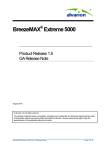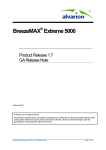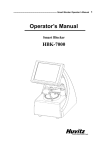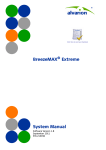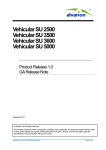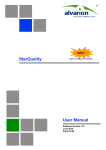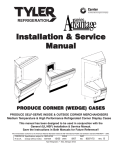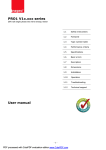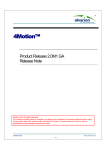Download BreezeMAX Extreme 3650_Ver.1.5_GA RN
Transcript
® BreezeMAX Extreme 3650 Product Release 1.5 GA Release Note June 2010 © Alvarion Ltd. All rights reserved. The material contained herein is proprietary, privileged, and confidential. No disclosure thereof shall be made to third parties without the express written permission of Alvarion. Alvarion reserves the right to alter the specifications in this publication without prior notice. BreezeMAX Extreme 3650 Ver.1.5 Release Notes Page 1 of 15 General This document details the main hardware elements, software features, known limitations, bug fixes, and version compatibility information as well as the documentation available for the BreezeMAX Extreme 3650 product release 1.5. It corresponds to software versions: • Software version 1.5.1.57 of BreezeMAX Extreme 3650 base-station • Software version R4.6.0.3-20569-v5.7.32.2 of BreezeMAX PRO 3000 CPE The Product Released BreezeMAX Extreme is a state-of-the-art all-outdoor, all-in-one WiMAX 16e (IEEE 802.16e-2005) based platform, working in the 3.65 GHz band, operating in TDD, and compliant for usage in North-America market. BreezeMAX Extreme offers all the advantages of the WiMAX 16e to the semi-licensed frequency band. Leveraging the carrier class QoS along with the superior radio technology, formed in a small all-outdoor highly integrated design presenting an exceptionally attractive cost/performance ratio for various needs and deployment scenarios, improving operational costs and reducing complexity. The BreezeMAX Extreme 3650 base-station, BreezeMAX PRO 3000, and BreezeMAX PRO 1000 CPE covers 3650-3700 MHz band. With this release the certified band for use is the 3650-3675 MHz frequency band. The BreezeMAX Extreme hardware is ready for the upper 25MHz (3675-3700 MHz) that would be enabled on future release by software upgrade. With BreezeMAX Extreme release 1.5 the following country profiles are allowed for use, any other country profile is prohibited: 3.65 GHz Extreme model (3650 – 3700) Universal FCC Canada Important notes: ONLY experienced installation professionals who are familiar with radio equipment for outdoor/indoor, local radio regulations, relevant local building and safety codes and, wherever applicable, are licensed by the appropriate government regulatory authorities should install outdoor units and antennas and should do so in accordance to the local regulations applicable. BreezeMAX Extreme 3650 Ver.1.5 Release Notes Page 2 of 15 About this Release Release 1.5 of the BreezeMAX Extreme is based on release 1.1 and introduces enhancements and new features as well as new models. Release 1.5 introduces the following new elements and capabilities. Extreme BTS Product Models New in this release: • Dual Sector SISO – A Single Input Single Output solution, serving two sectors in a single box, external antenna only. Supports up to 10MHz per each served sector. P/N Description BreezeMAX Extreme All outdoor base station, 30dBm transmit power, dual sector (2x10MHz) SISO no diversity, XTRM-BS936504 3650 – 3700 MHz band. Mounting kit included. 2SIS-3.7-EXT-SP Power Supply, External antennas, and indoor to outdoor cable are NOT included and should be ordered separately. Supporting also the previously available models: • Product Single Sector MIMO – A Multiple Input Multiple Output solution, serving a single sector, comes with either integrated or external antenna P/N Product 936502 XTRM-BS1DIV-3.7-90DS-SP 936503 XTRM-BS1DIV-3.7-EXT-SP Description BMAX Extreme BTS, single sector, 2nd order diversity, 3650 – 3700 MHz band, attached 90 degrees dual slant antenna. Mounting kit included. Power Supply and indoor to outdoor cable are NOT included and should be ordered separately. BMAX Extreme BTS, single sector, 2nd order diversity, 3650 – 3700 MHz band, external antenna. Mounting kit included. Power Supply, External antenna/s, and indoor to outdoor cable are NOT included and should be ordered separately. BreezeMAX Extreme 3650 Ver.1.5 Release Notes Page 3 of 15 Extreme CPE Product Model New in this release: • New PRO3000 CPE models - Outdoor, MIMO CPE, 2Rx 1Tx, integrated antenna: P/N Product Description 736800EU 4M-CPE3000-PRO1D-3.6 4Motion BreezeMAX PRO 3000: Outdoor CPE 3.6-3.8 GHz, with integrated Antenna. Indoor power supply is included. Indoor to Outdoor cable (CBL-BB) to be ordered separately. 736800US 4M-CPE3000-PRO1D-3.6 4Motion BreezeMAX PRO 3000: Outdoor CPE 3.6-3.8 GHz, with integrated Antenna. Indoor power supply is included. Indoor to Outdoor cable (CBL-BB) to be ordered separately. Supporting previously released: • PRO 1000 CPE - Outdoor, PRO CPE, 1Rx 1Tx, Integrated vertical antenna or external antenna model End-to-end System Components New in this release: • GPS chaining cable P/N Product Description XTRM-CBL-GPSExtreme base-station GPS chaining cable - 5m. 935010 CHAIN-5 RJ45 crimped (without boot) in both ends • IOT with the external 4Motion mini-centralized ASN-GW • IOT with FreeRADIUS AAA server Supporting also: • All-outdoor Extreme BTS, with the following integrated capabilities o ASN-Gateway o GPS receiver o Integrated dual-slant antenna (external antenna model also available) o Local provisioning option (no AAA mode) • BTS cabling for power (DC), data, external antennas • GPS antenna kits (Basic and High-Profile models) • Sector Antennas (for external antenna model) • Outdoor CPE • PoE to feed the CPE • SAU – Subscriber Alignment Unit, for ease of installation and alignment of CPEs (PRO 1000 CPE only) BreezeMAX Extreme 3650 Ver.1.5 Release Notes Page 4 of 15 • AAA IOT: Radiator (verified with version 4.4), Alepo (verified with version 7) • ASN IOT: Integrated, external over R6 • NMS: • o AlvariSTAR – Network Management System o StarACS – TR69 based CPE Management System Installer Aid: o AlvariCRAFT – Element Management and Installation Assistance Application Main Features The following new features and functionalities are supported with this release. • MIMO B increased capacity Available in the diversity base-station models (DIV), enabling increased served capacity in the downlink. A new sector diversity mode is supported (MIMO matrix A&B), on top previous modes (MIMO matrix A). Under MIMO A&B the system automatically selects per each subscriber according to its link conditions and subscriber capabilities if it uses matrix A (for increased coverage gain and link robustness) or matrix B (for increased capacity). • New 7 MHz channel bandwidth support Supporting 7 MHz channel bandwidth, on-top the previously available 5 and 10 MHz. This enables in the 3.65 available 25MHz utilization of 3 independent sectors of 7 MHz each. • Extended bandwidth support (7+7, 10+10 MHz) Increasing the served bandwidth of single sector models (either SISO or MIMO) for dual carrier – 10+10 MHz or 7+7 MHz by a single base-station, and hence practically doubling the served capacity. This feature is available under feature license (950201). Note that the CPE (working at 7 or 10MHz) would associate to either of the dual-carrier BTS, it is recommended that the BS_ID of each 7 or 10MHz would be configured differently such that sector "load balancing" can be achieved by setting the preferred BS of part of the CPEs equally between the two different BS IDs. • Dual SISO sector configuration support A new base-station model, serving two different sectors with Single-Input-Single-Output. Each of the sectors would be separately configured, and may serve up to 10MHz per each sector. This model creates a great offering for lower teledensity deployments, leveraging a single housing, single ASN, single feeding and backhaul for the two sectors. • GPS chaining capability Starting release 1.5, deploying a multi-sector site can benefit from chaining the GPS signal between the BTS in the site. One BTS acts as master and connects to the GPS antenna. The rest of the BTS on site (up to 4 additional BTS) are daisy-chained using CAT5e cable (in GPS-out, GPS-in connectors or the BTS). The base-stations are configured according to their position in the chain, and in case that the master would fail to generate the 1 PPS signal, the BTS configured as 1 in the chain would generate to the others, in case it would fail BS#2 in the chain would generate, etc. BreezeMAX Extreme 3650 Ver.1.5 Release Notes Page 5 of 15 • eRT Quality-of-Service Profile eRT (Extended Real-Time) Quality of Service is designed to support real-time applications, such as VoIP with silence suppression, that have variable data rates but require guaranteed data rate and delay. eRT creates periodic allocations in the downlink and uplink for the voice traffic similar to UGS, but on-top UGS is suppresses silence and performs the allocations only when talk spurt is detected, as such it guarantees high voice quality of service with optimization of the air-link usage and capacity. For details on the various QoS parameters settings please refer to the system manual. • Feature-licensing Starting with release 1.5, operators and integrators can benefit from "build-per-need" and "pay-asyou-grow" model. On the 3650 Extreme Base-Station, feature license for extended channel bandwidth support (10+10 or 7+7) is available. • Extended cell-range In a TDD scheduled protocol the max cell range is dictated by the silence duration between the DL and UL zones. Starting with release 1.5 operators can configure the max cell-range to be either 8km (as in previous releases) or 40km. • Enhanced Interference mitigation – MAPs repetition As part of the transmission, the MAP is a very important part as it lays-out the frame structure and DL/UL allocations. If a CPE can not interpret the MAP due to high level of interference, it would discard the entire frame. To have a more reliable and resilient transmission starting this release you may configure the MAP repetition (x2, or x4 repetition) to have a higher reliability. • Limited Ethernet Convergence Sub-layer (Eth.CS) depending on CPE capabilities Introducing Ethernet convergence services and classifiers as detailed below, enabling limited L2 based services and deployment scenarios based on CPE capabilities o Supported Classifiers The following classifiers are supported with this release under Ethernet-CS: 1. L2: VLAN ID (802.1q) – classification based on the VLAN identifier field Supported by PRO-1000 CPE (not yet by PRO 3000 CPE) 2. L2: VLAN Priority (802.1p) – classification based on the VLAN priority field Supported by PRO-1000 CPE (not yet by PRO 3000 CPE) Note: DSCP and PPPoE EtherType are not supported by current CPEs and should not be defined. o MAC Address Learning (Internal ASN-GW feature) The internal ASN-Gateway learns the source MAC addresses (creating a bridge database table) of packets coming from the R1 (i.e. packets sent from the MS toward the BTS). This table (size 1024) has an aging mechanism with fixed age timeout of 10 minutes. o MAC Address Learning Max-Size (Internal ASN-GW feature) A security feature in the internal ASN-Gateway, enabling limitation of the maximum number of learned MAC addresses. This feature is disabled by default, once enabled would limit the size of the MAC address learning table to the set size, once the size limit reached, packets coming from unknown MAC addresses would be dropped. BreezeMAX Extreme 3650 Ver.1.5 Release Notes Page 6 of 15 o MAC Address Deny List (Internal ASN-GW feature) A security feature in the internal ASN-Gateway allowing configuration of denied (blocked) MAC addresses. Packets coming from the R1 with source MAC address that appears in the deny list would be dropped, and packets coming from the network with destination MAC address that appears in the deny list would be dropped. o Deny/Allow MAC Address/Ranges(Internal ASN-GW feature) A new security feature, introducing filtering mechanism to allow/deny service to specific end user devices based on their MAC Address. Configuration can be done also over a MAC Address range. o Relaying Functionality (Internal ASN-GW feature) Once enabled this feature supports internal relay within the sector without sending the packet towards the network (backbone). This means that a packet coming from the R1 (towards the BTS) with destination MAC address hat was learned before (i.e. appears in the MAC address table) would be relayed back towards the R1 to the designated destination. o Forward Unknown Functionality (Internal ASN-GW feature) A security feature in the internal ASN-Gateway. Once enabled, this feature would allow incoming multicast or unknown destination unicast coming from the network, these packets would be transmitted over the R1 (from the BTS towards the CPE) as multicast messages over the multicast connection. If the feature is disabled, such packets would be dropped. Incoming Broadcast packets (from the network) are always forwarded and transmitted towards the MSs over the multicast connection. • Enhanced Interference mitigation – BTS Spectrum Analyzer For better initial site commissioning, and as a debugging tool, starting with Release 1.5 the basestation can perform spectrum analysis over a configured frequency range. The base-station scans over the configured frequency range the central frequencies. At each frequency it measures the RSSI (over all applicable sub-carrier frequencies), and calculates the median RSSI (of all sub-carriers). Note: The Spectrum Analysis test is a service affecting operation – during the scan the basestation would seize to serve the units associated to it. • Multicast & Broadcast profile With release 1.5 you may benefit from downlink broadcast and multicast enhanced capabilities. The multicast profile is configured within the forwarding rule in the service profile. Up to 10 different multicast groups can be configured. The multicast transmission is performed only once over the air and is performed in the configured "basic rate". The service configuration includes the MIR for the multicast service. • Reliable video profile A new quality of service profile for video applications, aiming to provide a reliable, error-free transmission. BreezeMAX Extreme 3650 Ver.1.5 Release Notes Page 7 of 15 • Networking deployment enhancements – DHCP server, relay, and forwarding option 82 With release 1.5 we had enhanced the networking deployment options of Extreme, adding on-top the DHCP transparent mode also DHCP server, and DHCP forward and relay with option 82 support. • o Transparent: As supported by previous releases. Typically used with IP CS service interfaces. The MS communicates directly with a DHCP server without involving the ASN-GW. o Forward With Option 82: Similar to the Transparent mode, with the ASN-GW adding Option 82 (Relay Agent Information) to DHCP messages forwarded to the backbone and removes them from received messages before forwarding them to the MS. Any DHCP discovery/request message coming from the user that includes option 82 will be dropped. o Relay with Option 82: The ASN-GW serves as a relay for DHCP messages between the MS and a known DHCP server. The implementation complies with RFC-2131 and RFC-3046. Any DHCP discovery/request message coming from the user that includes option 82 will be dropped. o Server: The ASN-GW acts as a DHCP server Default gateway per service group In IP-CS mode, ability to configure a different default gateway per each service group. • Default Service Profile & Default MSF For easier service definition "templates" of defaults for service profile and MSF are available. • Backhaul CPE support Improved deployment scenario – when feed by direct 48V DC, the base-station may feed the backhaul CPE (e.g. BNB, VL, or even an Extreme CPE). • BTS link statistics Modulation counters per each rate in the downlink and uplink, with indication of MIMO A and MIMO B in the downlink. Further there is ability to view continuous CINR/RSSI per each active MSs. Network Management Support Base Station Management The BreezeMAX Extreme base station is managed either by AlvariCRAFT as single element management (installer assistance), AlvariSTAR as a Network Management System or via Telnet. Release 1.5 of BreezeMAX Extreme Device is supported starting from Infrastructure version 4.5.0.46 of AlvariSTAR and AlvariCRAFT. AlvariSTAR Infrastructure 4.5.0.46 version has to be installed on AlvariSTAR platform with Extreme Device Driver 1.5.0.46. CPE Management The BreezeMAX PRO CPEs are managed either through a web interface for a single element management or over TR-69 using the StarACS CPE management system. Release 1.5 of BreezeMAX Extreme is supported starting StarACS version 2.8.5.5 BreezeMAX Extreme 3650 Ver.1.5 Release Notes Page 8 of 15 Documentation • • • There are two major independent manuals, the Base Station System Manual and the CPEs Product Manual. Each manual covers all relevant topics associated with the respective equipment, including: o Product / system description o System installation o Commissioning o Operation and administration. The documentation includes the following: o BreezeMAX Extreme Base Station System Manual o BreezeMAX Extreme Base Station Quick Installation Guideline o BreezeMAX Extreme CPEs Product Manual o BreezeMAX Extreme CPE Quick Installation Guideline o BreezeMAX Extreme Traps and Alarms o AlvariSTAR User Manual (part of AlvariSTAR CD) o AlvariCRAFT User Manual (part of AlvariSTAR CD) The following documents are also available: o • BreezeMAX Extreme 3650 BTS Technical Specifications The following applications notes are also available: o Application Note: Preparing cables for the BreezeMAX Extreme o Application Note: BreezeMAX Extreme operating with AAA o Application Note: BreezeMAX Extreme operation under local provisioning Upgrading Software to Release 1.5 Please note that upgrading the software to release 1.5 involves several steps and recommendations. A dedicated document to cover the upgrade procedure for the BTS is available. The following is a general description: • BTS upgrade to release 1.5 should include update of the firmware version as well as update of the Country Code configuration files (two files, named COUNTRY_CODES.sig and RFU_HEADS.sig); • CPE upgrade can be performed either through the LAN or over the air; BreezeMAX Extreme 3650 Ver.1.5 Release Notes Page 9 of 15 Supported Deployment Scenarios *Eth CS depends on CPE support (partially supported by PRO 1000, planned for future release for PRO 3000) BreezeMAX Extreme 3650 Ver.1.5 Release Notes Page 10 of 15 Recommendations / Important Notification When deploying the BreezeMAX Extreme 3650, please refer to the following recommendations: 1. Base Station ID configured in each channel must be unique in the entire network. Specifically when operating a dual-carrier BTS (e.g. 7+7 or 10+10) it is recommended to configure a unique BTS ID per each carrier to enable load-balancing. 2. The quality-of-service service profile configurations supported with this release are – BE (Committed Priority; CP=0), nRT (CP=1, 2 is supported), and eRT (CP=3 to 7). Suggested services configuration: a. Data: BE b. CPE Management (TR-069): nRT=1 c. Voice: eRT=5. 3. In the external AAA, the re-authentication timer (AK Life time) should be set to a value higher than 1hour. 4. When operating with external provisioning (AAA), if connectivity with AAA is lost the BTS will continue to function with previously authenticated MSs. When connection with AAA is reestablished the entire cell will be authenticated again (automatic de-registration of all CPE). 5. When working in IP-CS mode with a router behind the CPE, it is recommended to set the "Ethernet Downtime" on the CPE to be sufficient for the router to detect that the PHY is down and apply a DHCP renew – the value may vary between various router vendors. 6. When installing GPS antennas it is highly recommended to follow GPS antennas and receiver installation instruction and install the GPS antennas under clear sky. 7. When deploying a multi sector site it is recommended using a single high profile GPS antenna kit along with GPS chaining cable (CAT5e cable) between the base-station on the same site. 8. When performing software upgrade for the BreezeMAX Extreme CPE through the StarACS the behavior is as following: a. Software is downloaded to the unit b. Upon successful completion the unit set automatically "run from shadow" and performs reset itself. c. After link with BTS is established, the new version is Set as main automatically by the device 9. DHCP server for the CPE management IP or the hosts behind the CPE should not contain the IP addresses pool range of 192.168.254.0 to 192.168.254.255. This is mainly since IP address 192.168.254.251/24 is the static local IP address (from the LAN) and as such reserves this subnet for local CPE provisioning. 10. When working with External ASN-GW, please make sure that the networking device between the BTS and the ASN-GW supports MTU bigger than 1500 11. When using forwarding with option 82, if the Service Group gateway is a Cisco router the following configuration must be add on the Cisco to permit the DHCP packets to pass: “ip dhcp relay information trust-all“ 12. If additional devices are between the access router and BTS, these should forward without modification the DSCP marking. On CISCO switches the command is “mls qos trust dscp” 13. When using Linux DHCP server, the default setting should be that the DHCP Offer is sent as broadcast. BreezeMAX Extreme 3650 Ver.1.5 Release Notes Page 11 of 15 14. After switching between Operation Modes (e.g. between a SINGLE-SECTOR-SINGLE-BS to SINGLESECTOR-DUAL-BS), please make sure you are updating the bandwidth and central frequency to the desired values (e.g. from 10MHz to 20MHz). 15. When a base-station operates in 20MHz (10+10MHz dual carrier) the actual used channels by each of the carriers is offset by ±BW/2. i.e. when operating with 10+10MHz (set in the BS as 20MHz), each one of the dual carriers would be ±5MHz than the configured central frequency. As the CPE is always operating with 10MHz the central frequency it should look for one of these BWs. 16. If the sector includes only PRO 3000 CPEs, the performance per a single CPE can be boost up by configuring the HARQ DL buffers to 16 (by default set to 10). Such settings are not applicable If PRO 1000 or SI 1000 are used in the sector. Known Issues and Limitations With Release 1.5 described herein, the BreezeMAX Extreme 3650 system is introduced with the following limitations: Base-Station 1. ETH CS is partially supported (dependant on the CPE support) 2. The Ethernet port supports only Auto Negotiation mode. 3. The quality-of-service service profile configurations supported with this release are – BE (with CP=0), nRT (with CP=1 or 2), and eRT (with CP=3 to 7). 4. The GPS synchronization may take up to 30min when installing the base station in a new location, installer may refer to the GPS Menus as detailed in the system manual 5. Upgrade to Release 1.5 involves also update of the following files: COUNTRY_CODES.sig, RFU_HEADS.sig, ODU_bands.sig 6. Ethernet CS is supported only with the Integrated ASN-Gateway. i.e. when working with external ASNGW only IP-CS services are supported. 7. Classification by VLAN ID = 4096 is not supported 8. Any service modification requires MS de-registration in order to take place. 9. IP addresses that are not learned through DHCP process when the service is IP CS will not be allowed to perform traffic. If static routes are added to a device acting as DHCP client the routed classes will not perform traffic. Newly Added with Release 1.5 10. Two service flows which have the same priority are equalized by the CPE at packet rates and not bit rates (the packet sizes are not taken into account). 11. Under GPS chaining, when there is a faulty chaining cable, the radio units in the chain may not initiate transmission. 12. Under GPS chaining the master presents GPS External 1PPS and External 10MHz as OK even if the GPS chaining cable is not connected. 13. Under 20 (10+10) MHz or 14 (7+7) - When RF Channels are disabled, the operational status of the radio-channel is presented as Up. 14. Under dual sector SISO base-station, running a spectrum analyzer on one sector may lead as part of the scanning to BTS restart affecting the operation of the second sector. BreezeMAX Extreme 3650 Ver.1.5 Release Notes Page 12 of 15 15. Backhaul CPE can not be self-backhaul as such configuration requires Eth.CS. 16. In some rare cases when the sector is configured to 40km cell range a CPE might fail network-entry, as a workaround configure the cell range to 8km cell range. 17. GPS holdover occurs if GPS signal is "lost" and eventually ends when GPS signal is reacquired. In case of frequent reoccurrences of GPS holdover events, the system may develop miss-synchronization that may eventually require BTS reset. Recommended workaround is to minimize GPS holdover events – improving antenna installation location (insure clear sky), use high gain profile antenna 18. When running Spectrum Analyzer while operating in dual sector mode, if system had developed misssynchronization because of GPS holdover, at the end of the scan process the system would reinitialize both channels. 19. In very rare occasions, the logical BS ID might be reinitiated. This can be observed in the trap events as “No TX/RX” and deregistration of the CPEs associated to this BS ID. The situation is auto recoverable and service is restored after few seconds. BreezeMAX Extreme PRO 1000 CPE 1. PRO 1000 traffic is limited to 3.2Mbps maximum in DL 2. Ping messages of 25000 bytes transmitted over R1 (to the host behind CPE) are sometimes unanswered. There is no issue observed with Ping messages of length up to 14K bytes 3. Software upgrade may fail if the WAN management IP is changed during the software upgrade process 4. Sending IP fragmented packets between the MS and the BTS may result in packet loss 5. Using PRO 1000 (or SI 1000) in BreezeMAX Extreme base-station can operate with HARQ DL Buffers in the base-station configured to 10 (default value in the BTS) – if the HARQ DL buffers would be configured to a higher value than 10 the CPE might fail to associate with the BTS. 6. Under Ethernet-CS, classification based on DSCP, and PPPoE EtherType are not supported and should not be used. BreezeMAX Extreme PRO 3000 CPE 1. Eth CS is not supported in this release in PRO 3000 2. IP-CS bridge mode (allowing multi classifiers) is not supported in this release of PRO 3000 3. Ping messages of 25000 bytes transmitted over R1 (to the host behind CPE) are sometimes unanswered. There is no issue observed with Ping messages of length up to 14K bytes 4. Software upgrade may fail if the WAN management IP is changed during the software upgrade process 5. Sending IP fragmented packets between the MS and the BTS may result in packet loss 6. Under firewall settings, “Deny” settings overrides “Allow" settings. To overcome this limitation, the user should define “Deny configuration” first and then define “Allow all” for all other 7. Web GUI is not accessible after disabling all user accounts (only Operator user can disable all user accounts). In this case the unit should be reset to factory defaults 8. The CPE supports only single data stream on one single Quality of Service level BreezeMAX Extreme 3650 Ver.1.5 Release Notes Page 13 of 15 Issues Observed During Interoperability Testing Radiator AAA During the Interoperability test with Radiator version 4.4 the following issues were observed. Note that these can be overcome with additional scripts and configuration of the default installed Radiator AAA: 1. Multi-host support behind a single CPE might not work. One may need extra scripts to support multiple host creation in the AAA behind a single CPE. 2. In case of abrupt link termination between the ASN-GW and the AAA, account sessions might remain open (active). One may need to implement timers or other logic scripts in the AAA to close these sessions. FreeRADIUS AAA During the Interoperability test with FreeRADIUS version 2.1.8 the following issue was observed: 1. FreeRADIUS default installation (of version 2.1.8) requires modification of several configuration parameters (in different files) to be able to work properly with a WIMAX 16e solution such as the Extreme, for details on required changes please refer to the application note: "Application Note: BreezeMAX Extreme operating with AAA" 2. FreeRADIUS cannot be used together with external 4Motion mini-centralized ASN-GW Bug Fixes Release 1.5 described herein, introduces the following bug-fixes: Base-Station 1. Up to 50 subscribers per BTS 2. Maximum cell radius supported with this release is up to 12km. Cell radius configuration should not be modified from its default value (40km). 3. MAP Repetition isn't supported in this release, using QPSK 1/2 with 0 repetition only (Default value). 4. GPS Chaining is not supported 5. Maintenance actions such as SW Download, Configuration backup/restore may affect dramatically the BTS performance 6. In stress conditions, after many de-registrations, the BTS could perform reset 7. The downlink PER counters cannot be manually reset 8. Counters that were not supported in previous release: a. HARQ ACK numbers (Bursts) per MS b. HARQ NACK numbers (Bursts) per MS c. HARQ drop (Bursts) per MS d. TOTAL BURSTS/ ERROR BURSTS per Rate. 9. GPS is not locking the satellites in good conditions 10. In IP-CS mode DHCP Discover packets are sent as L2 unicast BreezeMAX Extreme 3650 Ver.1.5 Release Notes Page 14 of 15 Compatibility Matrix With Release 1.5 described herein, the following compatibility matrix applies: BMAX PRO 1000 CPE 2.5.1.1045 BMAX PRO 3000 CPE R4.6.0.3-20569-v5.7.32.2 1.1 1.1 1.5 1.5 BMAX 3650 BST BMAX 3650 BST ver. 1.5 Ver. 1.1 CPE PRO 3000 version R4.6.0.3-20569-v5.7.32.2 R4.6.0.3-20569-v5.7.32.2 CPE PRO 1000 version 2.5.1.1045 2.5.1.1045 BTS version Note: if any element (CPE or BTS) is not of the recent release (1.5) not all of release 1.5 functionality would be supported. BreezeMAX Extreme 3650 Ver.1.5 Release Notes Page 15 of 15















